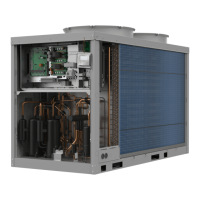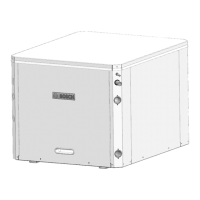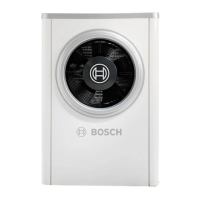Preparing for installation
7
Compress 5800i AW – 6721862724 (2023/06)
Fig. 7 Type plate position, inside of the appliance
[1] Type plate*
*The type plate contains information on the part number and serial
number and also the date of manufacture of the device.
2.8 Regulations
Follow the directives and regulations given below:
• Local provisions and regulations of the electricity supplier and
corresponding special rules
• National building regulations
• EN 50160 (voltage properties in power grids for public distribution)
• EN 12828 (heating systems in buildings - Design and installation of
water-based heating systems)
• EN 1717 (Protection of potable water against pollution in potable
water installations)
• EN 378 (Refrigerating systems and heat pumps - Safety and
environmental requirements)
• EN60335-2-40 (Particular requirements for electrical heat pumps,
air-conditioners and dehumidifiers)
• PED, 2014/68/EU (Pressure equipment directive)
2.9 Accessories
2.9.1 Required system components
The following components are not included in the standard delivery but
are required for the initial start up and operation of the system.
Heating system:
• Heating system circulation pump
•Buffer cylinder
• Membrane expansion vessel
• Cap valve for the expansion vessel
• Automatic air vent valve [VL1] for buffer cylinder
• Magnetite filter/separator (not necessary if the system only consists
of newly installed underfloor heating)
• Equipment for filling of the heating system
A non-return valve may be necessary to prevent self-circulation in the
heating system. This can mainly arise in the following situations:
▶ Heating system with radiators.
▶ The indoor unit is installed below the heating system (basement or
multi-story building).
▶ The outdoor unit is installed on the same height or below the indoor
unit.
Heat pump:
• Manual valve [VC4] between the indoor unit and the heat pump. The
valve is used when filling and venting the system. It is not allowed to
completely disconnect the heat pump from the indoor unit, therefore
only one valve is required
Parallel setup:
• Non-return valve if the buffer cylinder is installed in a parallel setup
and the cooling mode is active.
2.9.2 Optional accessories
The following accessories can be added on and are not required for
operation of the system.
• DHW cylinder (water heater)
• Automatic air ventilation valve for the DHW cylinder
• Thermostatic valve hot water
• Pressure relief valve DHW
• DHW circulation pump
• Filling equipment DHW
• Incoming cold water check valve
• Room controller
• Connect-Key K30RF
• Safety thermostat for under floor heating
2.9.3 Room controller
For higher system efficiency, it is recommended to integrate room
controllers instead of thermostatic radiator valves in the heating system.
The room controller provides feedback that will automatically adjust the
heating curve to control the room temperature. This ensures that the
heat pump will only operate when there is heating or cooling demand.
3Preparing for installation
The particle filter is installed horizontally in the return of the heating
system. Note the direction of flow of the filter.
The drain pipe of the pressure relief valve in the indoor unit must be
installed so that it is protected against frost, and the drain pipe must be
routed to the drain.
▶ Run the connector pipes for the heating system and cold/domestic
hot water in the building up to the installation location of the indoor
unit.
3.1 Placement of the indoor unit
NOTICE
Risk of damaging the product!
The product may be damaged if it is exposed to moisture. Do not install
the product in a bathroom or kitchen.
▶ Install the product in a dry area.
• The indoor unit is placed in the building. The pipework between the
heat pump and indoor unit must be as short as possible. Use
insulated pipes.
• The installation location for the indoor unit must have a drain.
• The ambient temperature around the indoor unit shall be between
+10 °C and +35 °C.
3.2 Water quality
3.2.1 Quality requirements for the heating water
The quality of the fill and top-up water is an essential factor for increased
efficiency, functional reliability, long service life and for maintaining the
operational readiness of a heating system.

